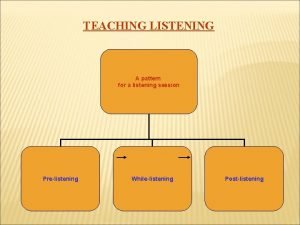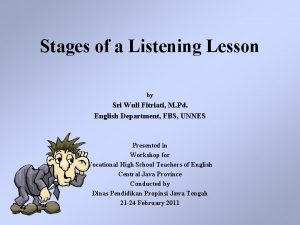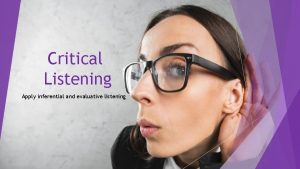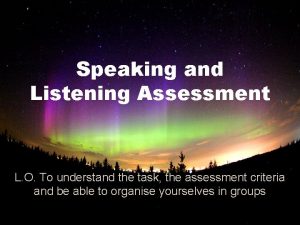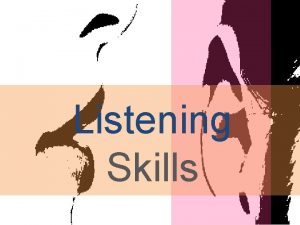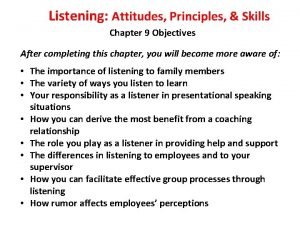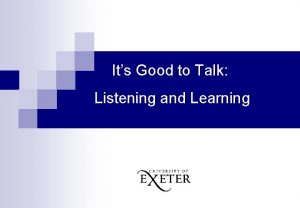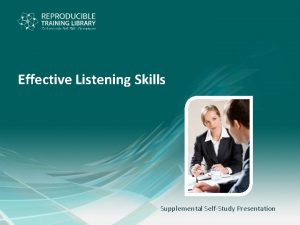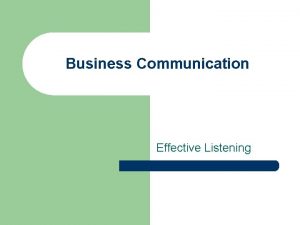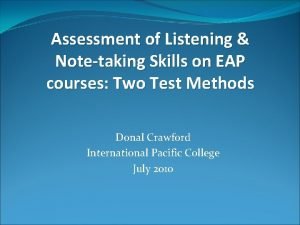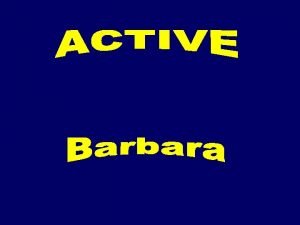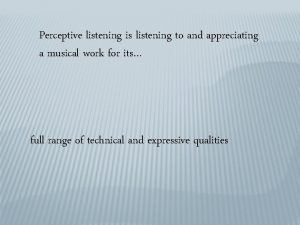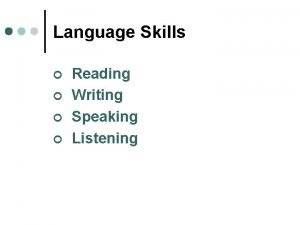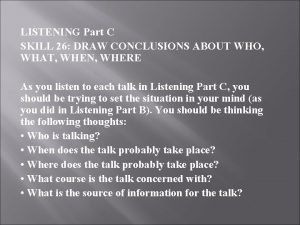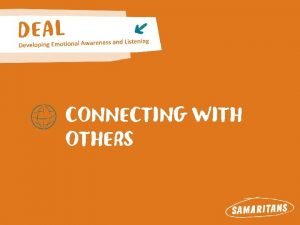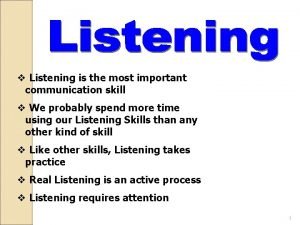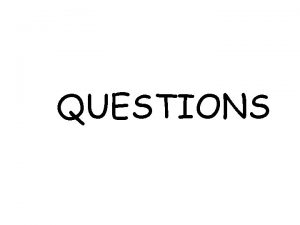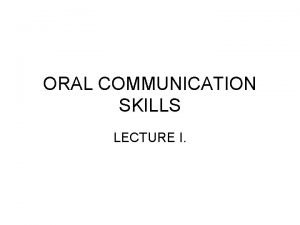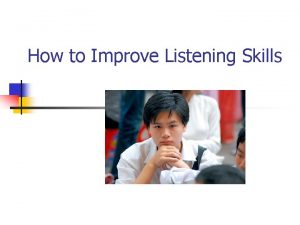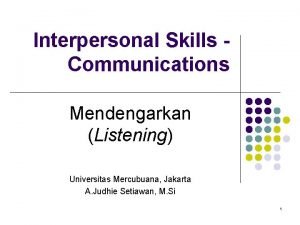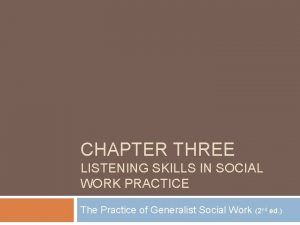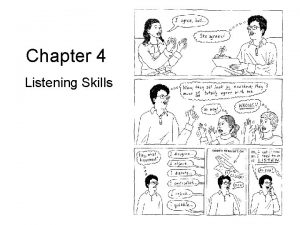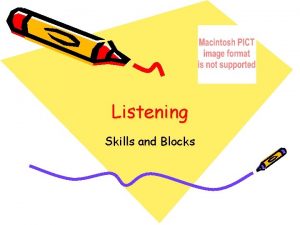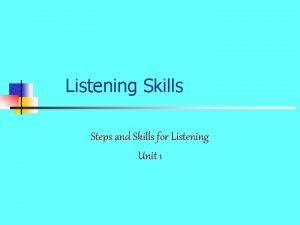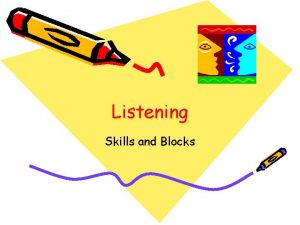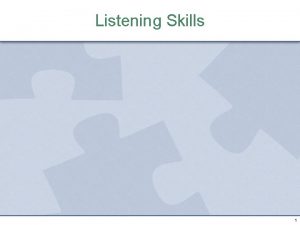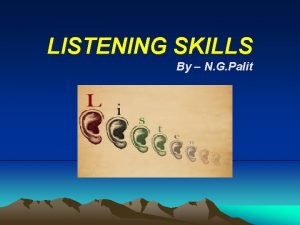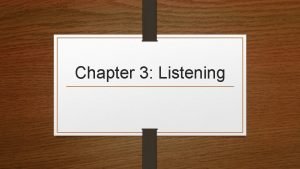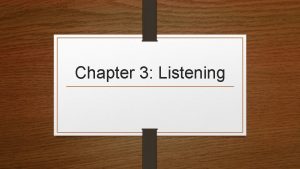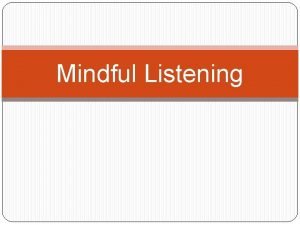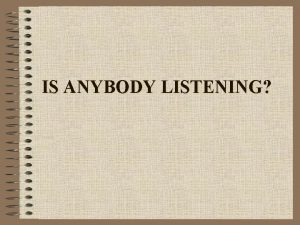Chapter 4 Listening Skills Listening Skills Introduction Listening


































- Slides: 34

Chapter 4 Listening Skills

Listening Skills: Introduction • Listening is an important skill for speakers. • Good listening can help: – During the research process – During practice when you receive feedback – During your speech as the audience gives you feedback

Listening Skills: Introduction • Hearing is passive reception. • Listening means actively paying attention to the message.

Listening Skills: An Overview • Reviewing the following topics will help you become a better listener: – The importance of listening – The process of listening – Causes of ineffective listening – Suggestions for improving listening


Why Listen? • Good listening can: – Improve a speaker’s connection with the audience by helping him or her respond to feedback – Help an audience member absorb information and critically evaluate claims

The Listening Process • Effective listening requires: – Processing what you have heard – Retaining what you’ve processed

The Listening Process: Processing What You’ve Heard • Processing involves actively thinking about both vocal and nonverbal messages and cues. – Allows a listener to make better decisions with the information

The Listening Process: Retaining What You’ve Processed • Retention is your ability to remember what you’ve heard. – Easier if you have good attention and listening skills • The attentiveness curve demonstrates the listening patterns of poor listeners.

The Listening Process: The Attentiveness Curve

The Culprits Behind Poor Listening: An Overview • • • Unprocessed note taking Nonlistening Interruptive listening Agenda-driven listening Argumentative listening Nervous listening

Culprits Behind Poor Listening: Unprocessed Note Taking • Unprocessed note taking means writing verbatim notes. • When taking notes, focus on the content of what’s being said. • Don’t take notes only to take notes.

Unprocessed Note Taking

Culprits Behind Poor Listening: Nonlistening – Not paying attention – It is as if the information is hitting a brick wall. – Retention is impossible.

Culprits Behind Poor Listening: Interruptive Listening • When one person consistently interrupts another • Audiences can interrupt to derail a speaker. • Speakers can also interrupt audiences, cutting off a question or comment.

Culprits Behind Poor Listening: Interruptive Listening • All interruptive listening is: – Rude – Limits listening – Decreases credibility and goodwill

Interruptive Listening

Culprits Behind Poor Listening: Agenda-Driven Listening • Focusing so much on what comes next in the speech you pay little attention to audience members – Annoys audience members and damages credibility


Culprits Behind Poor Listening: Argumentative Listening • Listening only enough to fuel your own arguments • May occur: – If audience disagrees – If speaker feels attacked – If interviewer disagrees with interviewee

Culprits Behind Poor Listening: Nervous Listening • Feeling compelled to talk through silences • Makes it difficult to gather and interpret information

Tips for Culprits Behind Poor Listening • Tip: Some silence is okay. If you feel compelled to speak during a pause, count to three before you speak. • Tip: Planning, preparation, and practice can help avoid unplanned silences and agenda-driven listening.

Becoming a Better Listener: An Overview • You can be a better listener by improving your interactive listening skills, which involves: – Filtering out distractions – Focusing on the speaker – Showing that you are listening

Becoming a Better Listener: Filter out Distractions • Try to ignore external distractions. • Try to blot out internal noise, or any thoughts that make it hard for you to concentrate. • Examples of internal noise include: – Worrying about your grade – Thinking about your social life

Becoming a Better Listener: Focus on the Speaker • Keep your mind on what the speaker is saying. • Do not consider what the speaker will say next. • Ask yourself questions about what you just heard.

Becoming a Better Listener: Show That You Are Listening • Nonverbal cues that indicate listening: – Alert posture – Head nodding – Eye contact • Verbal cues that indicate listening: – Asking questions – Paraphrasing audience member’s question


Maximizing Your Audience’s Listening: Anticipate Ineffective Listening • Perform audience surveillance. • Consider audience’s attention and energy levels. • Assess audience’s knowledge and abilities, then adjust. • Front- and back-load your main message. • Use presentation aids strategically.


Maximizing Your Audience’s Listening: Encourage Active Listening • Tailor your delivery by adjusting your voice, volume, fluency, projection, rate, and timing. • Acknowledge the viewpoints of argumentative listeners. • Pause for questions to help re-engage defeated listeners. • Engage superficial listeners by making eye contact or asking questions.

Maximizing Your Audience’s Listening: Encourage Active Listening

Listening When You Are in the Audience • Providing a speech critique can help you and the speaker. • A good critique provides constructive criticism: – Take notes. – Identify main points. – Consider speech’s objectives.

Listening When You Are in the Audience • Other considerations during the speech critique: – Support your feedback with examples. – Be courteous and nonbiased. – Hold the speaker accountable.

Tips for the Listening Process • Tip: Keep an open mind when listening; every listening experience is an opportunity for learning. • Tip: Listen to others as you would like them to listen to you.
 What is post listening stage
What is post listening stage Stages of a listening lesson
Stages of a listening lesson Interruptive listening
Interruptive listening Active and passive listening
Active and passive listening What does critical listening mean
What does critical listening mean Intensive listening
Intensive listening Speaking and listening assessment
Speaking and listening assessment Listening skills objectives
Listening skills objectives Objectives of listening
Objectives of listening Aims and objectives of listening skills
Aims and objectives of listening skills Presentation on listening skills
Presentation on listening skills Active listening in business communication
Active listening in business communication Listening and notetaking skills
Listening and notetaking skills Receptive skills listening and reading
Receptive skills listening and reading Listening objectives
Listening objectives Success criteria for listening skills
Success criteria for listening skills The way sounds are woven together
The way sounds are woven together Nature of listening
Nature of listening Reading listening writing speaking
Reading listening writing speaking Listening skills in social work
Listening skills in social work Skill 4 draw conclusions about who what where
Skill 4 draw conclusions about who what where Listening skills objectives
Listening skills objectives Listening and questioning skills
Listening and questioning skills Action plan for active listening
Action plan for active listening Listening comprehension rubric
Listening comprehension rubric Bottom up in listening
Bottom up in listening Samaritans listening wheel
Samaritans listening wheel Mindful listening key skills
Mindful listening key skills Insensitive listening
Insensitive listening Test your listening skills
Test your listening skills Communication conclusion
Communication conclusion Listening skills
Listening skills Importance of listening
Importance of listening Listening in interpersonal communication
Listening in interpersonal communication Social work listening skills
Social work listening skills
